Herd Immunity
- Immunization of a large population set;
- Provides a protective measure for the population;
- Makes it harder for a disease to spread;
- Fewer people left to be infected;
- Protects individuals who cannot be vaccinated;
- Children, individuals with immune issues, and the ill.
- Proportions vary depending on disease type.
In the discussion about immunization as an issue, it is important first to discuss herd immunity as a phenomenon implied to protect populations from infectious diseases.
As a result of immunization, herd immunity develops, with fewer people being infected.
Herd immunity is necessary for preventing the most vulnerable population groups from being infected. These include children who are too young to get vaccinated, individuals with immune diseases, as well as people that are currently ill and cannot get vaccinated.
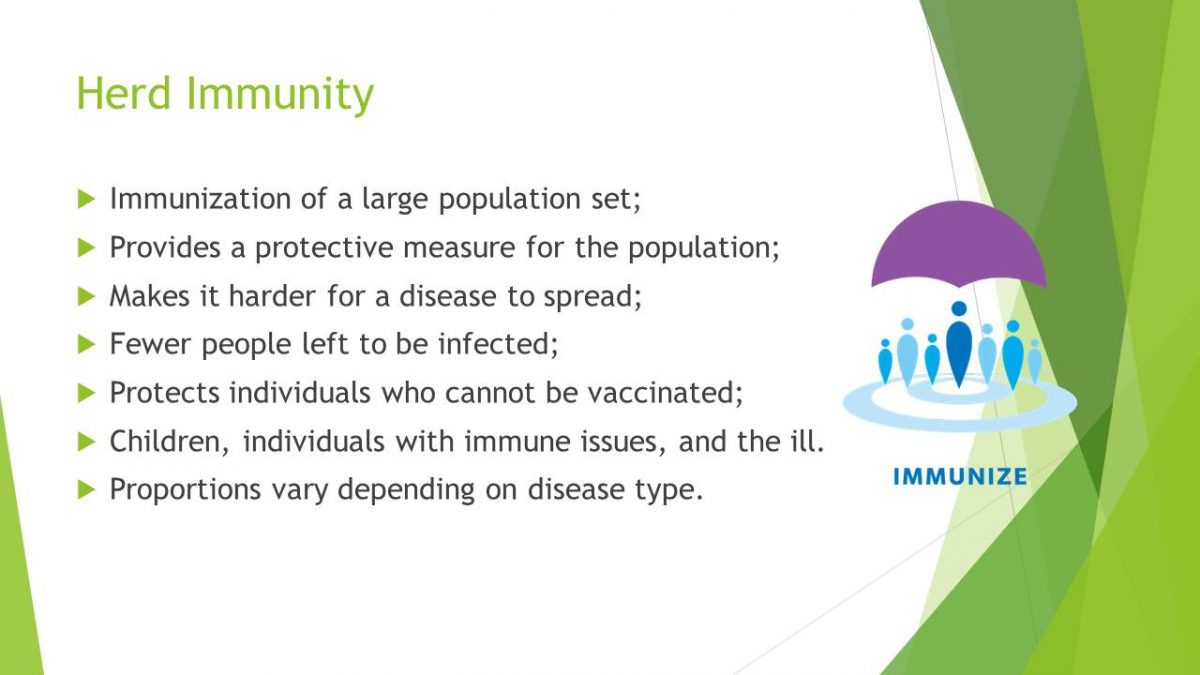
Types of Immunity
Active Immunity:
- Disease exposure triggers the immune system;
- Antibodies are produced as a response to the disease;
- Is long-lasting and can last an entire life.
Passive Immunity:
- A person is given antibodies to a disease;
- The immune system does not produce antibodies;
- Antibody-containing products are used.
Immunity is differentiated into active and passive depending on how it developed in the beginning.
On the one hand, there is active immunity, which develops as a result of disease exposure triggering an immune response of the body. It can last a long time, including the entire lifespan of people.
On the other hand, there is passive immunity, which is a result of immunization (often short-term). The immune system in this case does not produce antibodies.
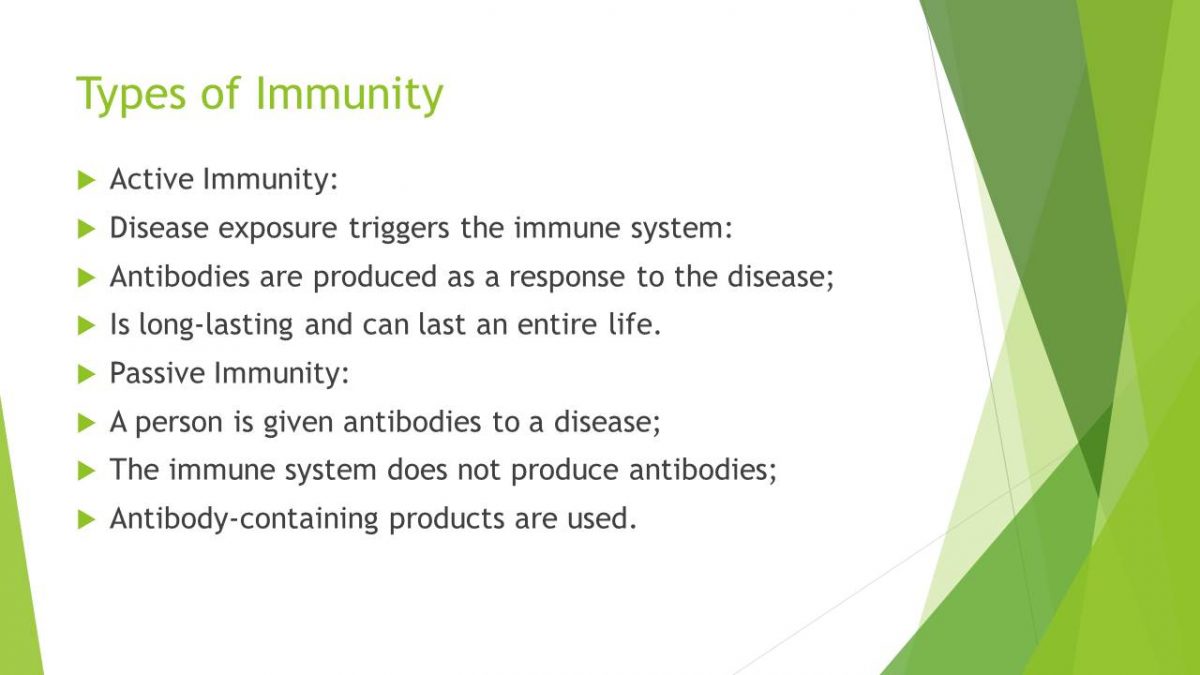
Effect of Vaccinations
- Eradication of major infections (e.g., smallpox) (Greenwood, 2014);
- A positive impact on productivity, overall health, and cognitive development;
- Adaptation to modification of disease epidemiology;
- Increase economic productivity;
- Protection against diseases within herd immunity;
- Strengthening of the immune system of people.
For public health, immunizations represent an effective tool for protecting the population from the adverse impact of preventable diseases. Their prevention leads to a positive impact on productivity, the overall health of the population, and the cognitive development of children.
Within the context of immunization as a real preventable measure, the latter creates a herd immunity environment through strengthening people’s immune system.
It should also be mentioned that there is a growing trend in opposing vaccinations in favor of natural treatments.
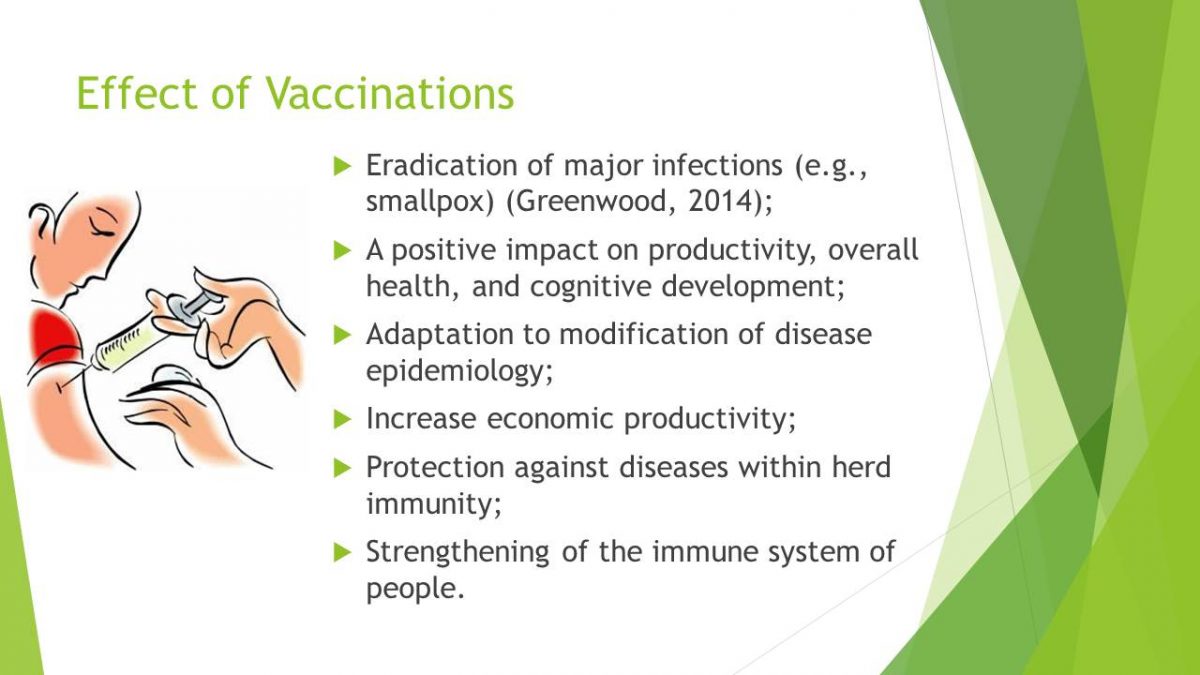
Worldwide effects
- Addressing deaths due to infection epidemics;
- Minimization of polio endemic in most countries (CDC, 2017);
- Aversion of deaths in low-income regions;
- Prevention of measles, yellow fever, rubella, hepatitis B, etc.;
- The increased cost-effectiveness of healthcare;
- The decreased occurrence of virus infections.
The global effect of immunizations has shown to be extremely positive. With the advancements in the testing and research of vaccines, the population has higher chances of being protecting itself from preventable diseases.
Such adverse illnesses such as measles, rubella, yellow fewer, hepatitis B, and others have decreased in occurrence with the administration of vaccinations.
In addition to the mentioned effects, vaccinations have brought increased cost effectiveness of healthcare. Instead of treating diseases, they are prevented, thus reducing their economic impact.
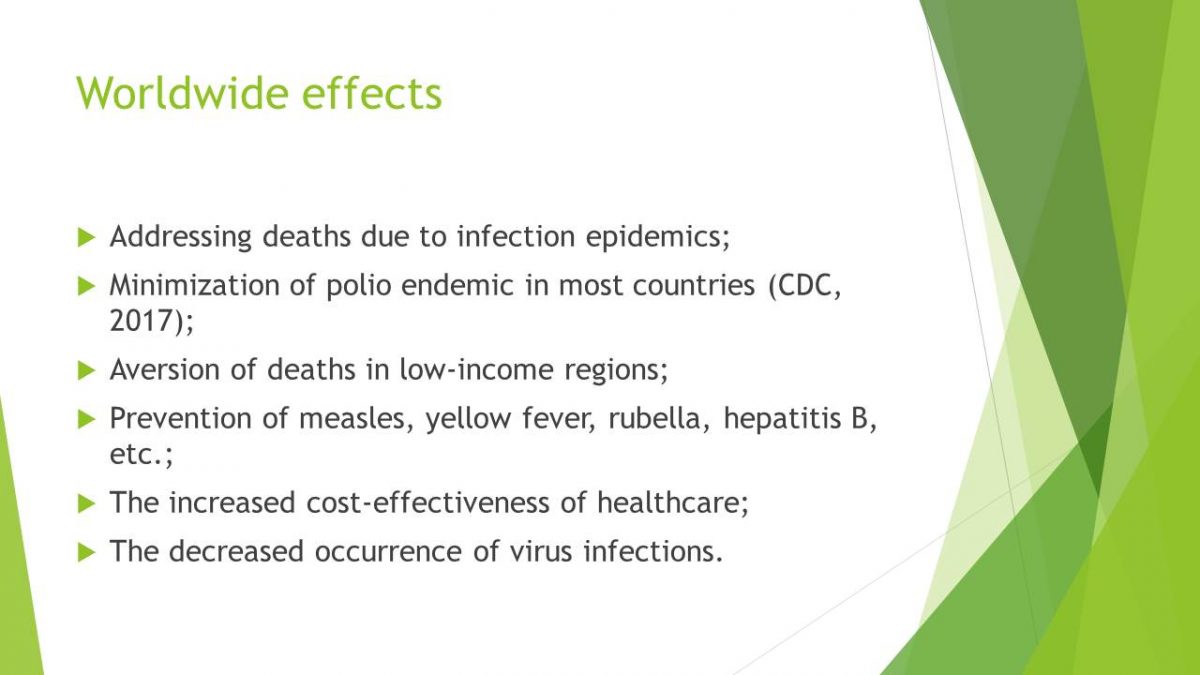
Vaccination Trends
- Vaccinations increased the confidence in health care;
- Direct correlations with GDP and education levels;
- Socioeconomic stability leads to increased vaccination;
- Polio epidemic (Pakistan and Afghanistan) driven by war;
- Vaccine refusals by religious and anthroposophical groups;
- Estimations of vaccine coverage are not always concrete;
- Possible artificial increases to boost statistics.
The main trend in contemporary public health is associated with increasing the confidence of the population in that vaccinations will protect their children against infectious diseases.
It should be mentioned that the economic stability of the population increases the likelihood of it being vaccinated. This means that improving the economic well-being of some groups.
However, it should be mentioned that the reported statistics on vaccination administration may not always reflect the real picture.

Vaccination Myths
- Vaccines contain harmful substances;
- In children, vaccines cause autism and sudden infant death syndrome;
- Vaccine-preventable diseases are part of growing up;
- It is better to have diseases than to become immune to them;
- Since other children are immune, there is no need to vaccinate;
- A disease can be caused by a vaccine.
The list of vaccination-related myths represents the fears that some people have when it comes to vaccinating their children. This presents some challenges for public health care.
These myths are especially important to understand because they represent the root of most people’s hesitations to vaccinate their children.
It is essential for healthcare providers to implement education interventions to develop their understanding that the positive effects of immunizations overweight the possible risks and side-effects.
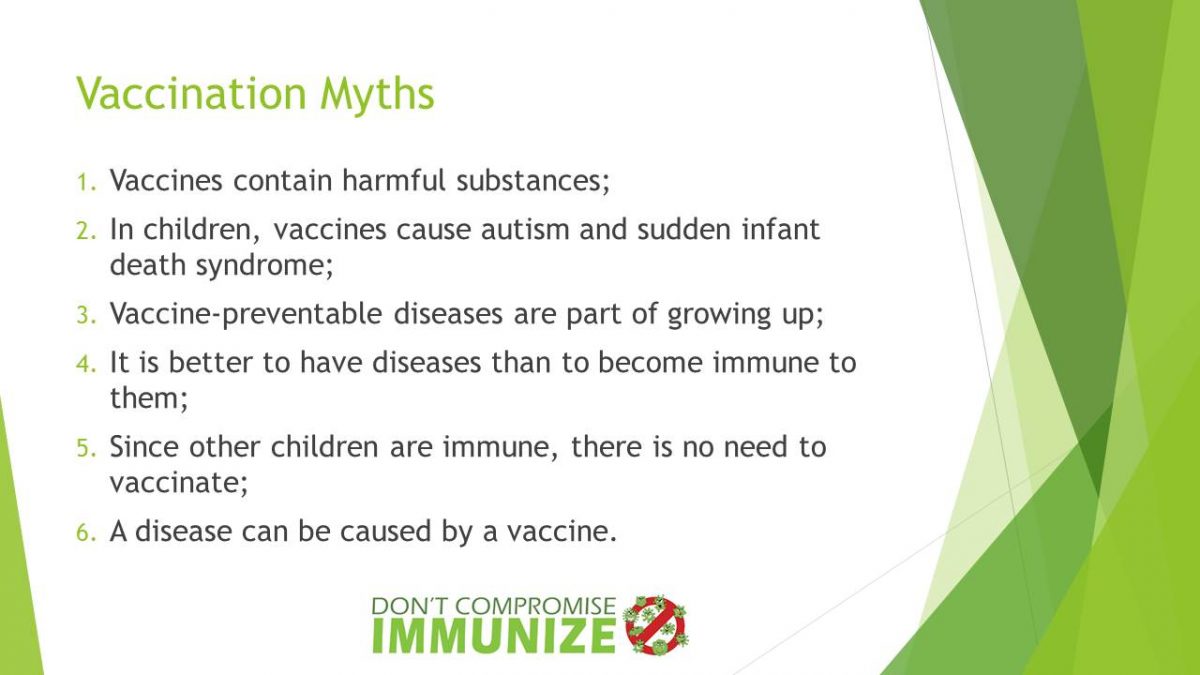
Vaccination Myths Disproved
- Any chemicals included in vaccines are in low doses;
- Vaccines are safe, and reactions to them are minor long-term (AAAAI, 2018);
- In childhood, vaccine-preventable diseases can cause significant harm;
- It is not better to have a disease because of complication risks;
- Relying on herd immunity leads to the decreased resistance to disease;
- Vaccines causing diseases are highly unlikely.
Addressing vaccination myths is necessary to ensure that the population develops a positive attitude to this effective prevention method.
It is important to understand that vaccines represent an effective means to reduce the transmission of diseases, disability, and the occurrence of infant mortality.
The list of counter-arguments to the myths is intended to inform the community that the advantages of vaccinations overweight the possible risks and short-term side effects.
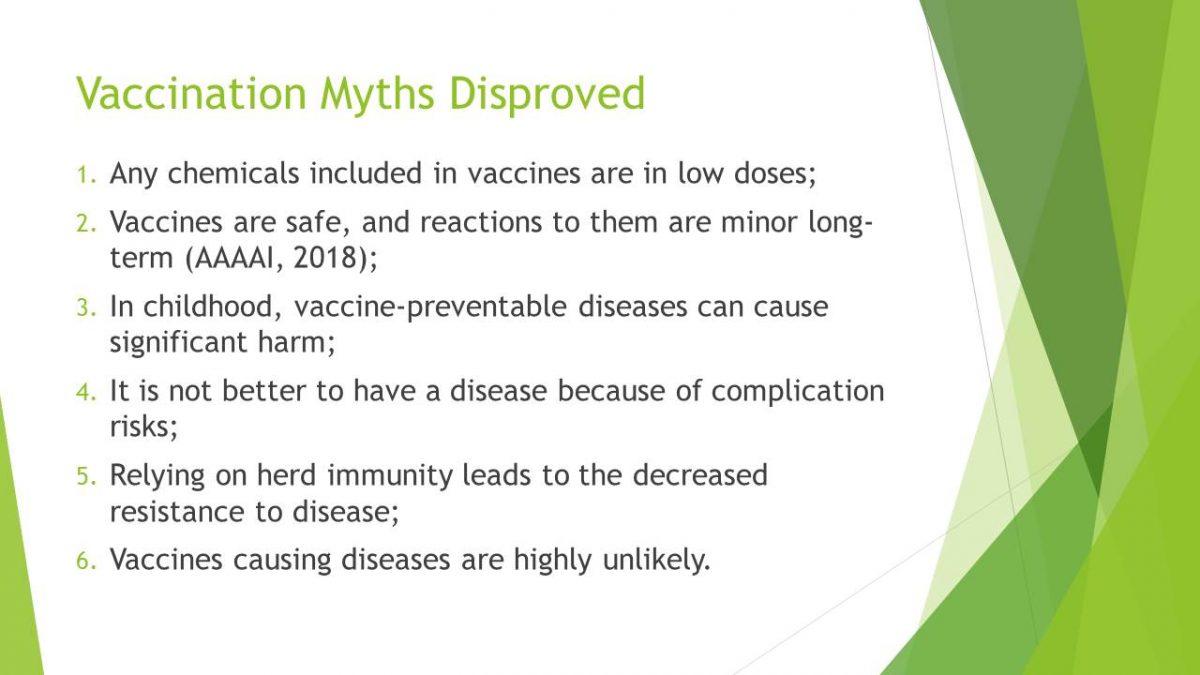
Disease Prevented by Vaccinations
- 79% decline in deaths associated with measles;
- Eradication of polio endemic (apart from Pakistan and Afghanistan);
- 23.3 million estimated deaths averted 2011-2020;
- 4.7 million Hepatitis B deaths prevented;
- 1.5 million Pneumococcus deaths prevented;
- 0.4 million Rubella deaths prevented (CDC, 2017);
- 0.8 million Rotavirus deaths averted.
The statistics reported by the Centers for Disease Control and Prevention on the slide illustrate the effectiveness of vaccinations in preventing diseases that lead to deaths in the population.
Pakistan and Afghanistan remain the most problematic areas in terms of polio due to the continuous military instabilities.
Nevertheless, vaccines showed to be effective in reducing the adverse impact of measles, Hepatitis B, Rubella, Rotavirus, and Pneumococcus. It has been prognosed that vaccines will continue making a difference.
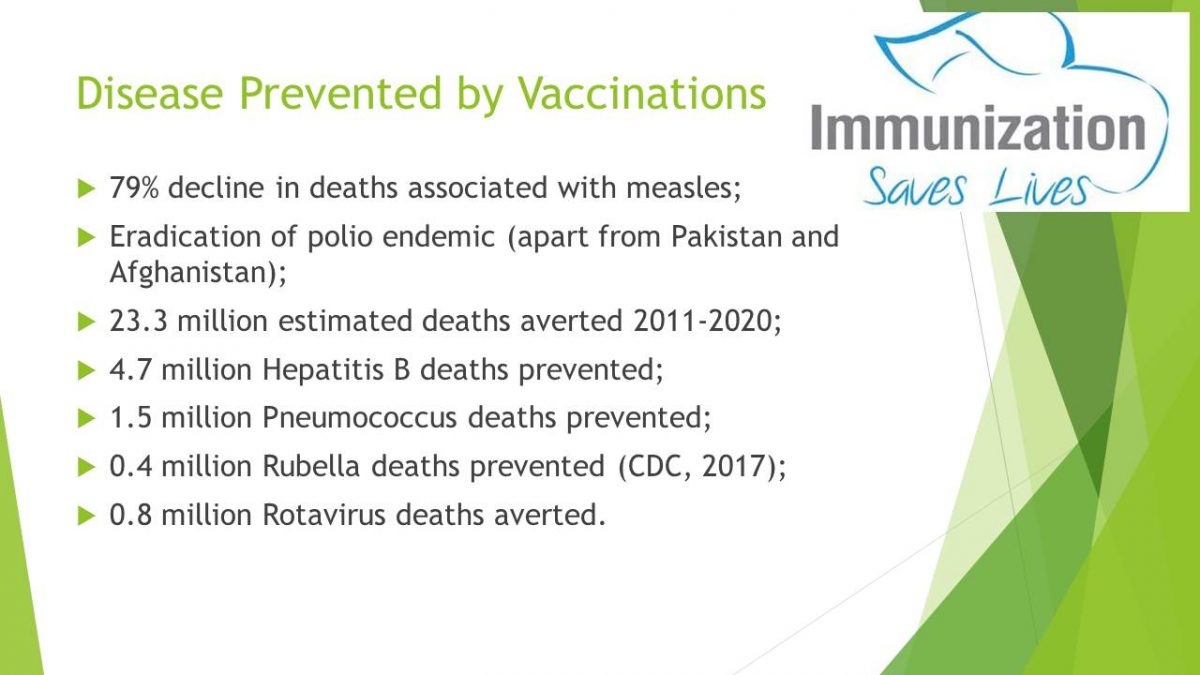
Pediatric Vaccination Schedule
- Hepatitis B: birth, 1, 2, 6-15 months;
- Rotavirus: 2, 4, 6 months;
- Diphtheria: 2, 4, 6, 15 months;
- Haemophilus influenza: 2, 4, 6, 12-15 months;
- Hepatitis A: 12-15 months;
- Varicella: 12-15 months;
- Influenza: annual vaccinations;
- Measles, mumps, and rubella: 12-15 months.
The recommended schedule for pediatric immunizations is intended to regulate the administration of the vaccines through the appropriate period of time.
The majority of vital immunizations occur in the first fifteen months of a child’s life, thus guaranteeing the protection of the organism against potentially harmful and dangerous infections.
Several doses (3-4) of vaccines for infectious diseases mentioned in the slide are spread apart between birth and fifteen months. Influenza vaccinations are recommended annually to sustain the organism’s resistance to them.
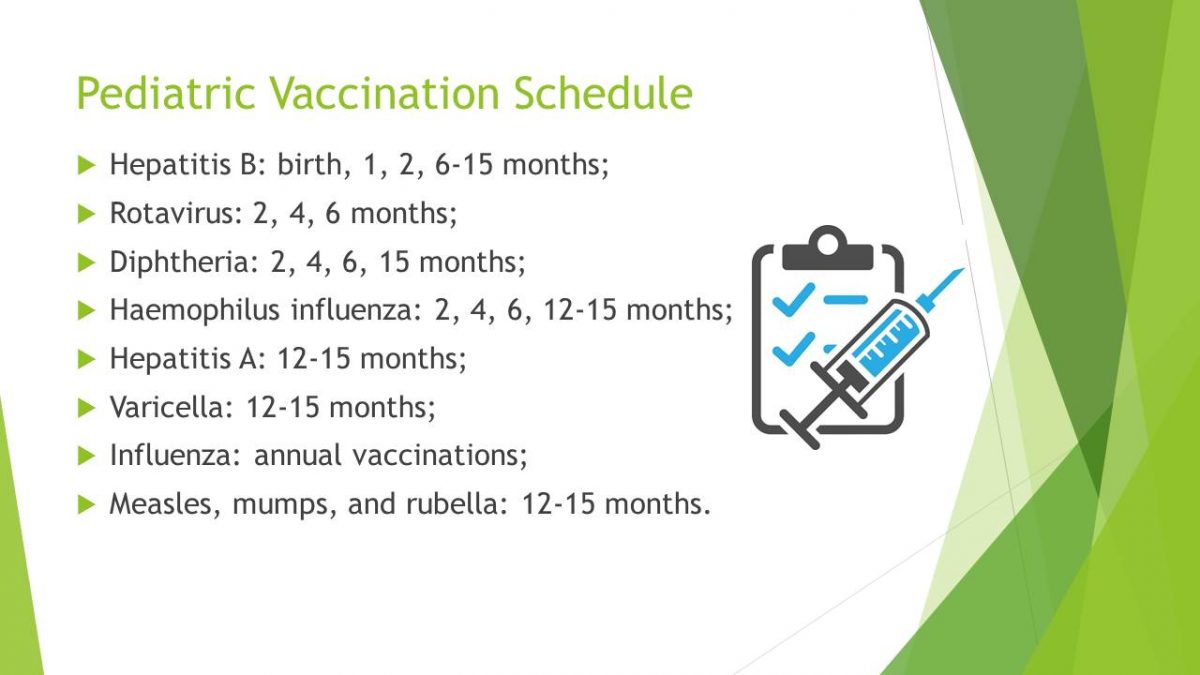
Legal Issues
- Rejection of vaccines leads to legal issues in public health;
- Mandatory vaccinations are intended to protect the population;
- Health authorities can impose vaccinations to maintain health;
- Controversies regarding the rejection are associated with religious ideologies;
- Freedom of religion practice presents many challenging;
- Enforcing vaccinations on the population may cause legal disputes;
- Human rights issues should also be considered.
The most legal issues occurring in the context of vaccinations are associated with the population’s refusal to administer them.
Because of this, mandatory laws have been developed in the US to ensure that the population is protected against the most commonly transmitted viruses.
However, forcing people to agree to vaccinate themselves and their children may transform into a limitation of basic human rights to make their own decisions.
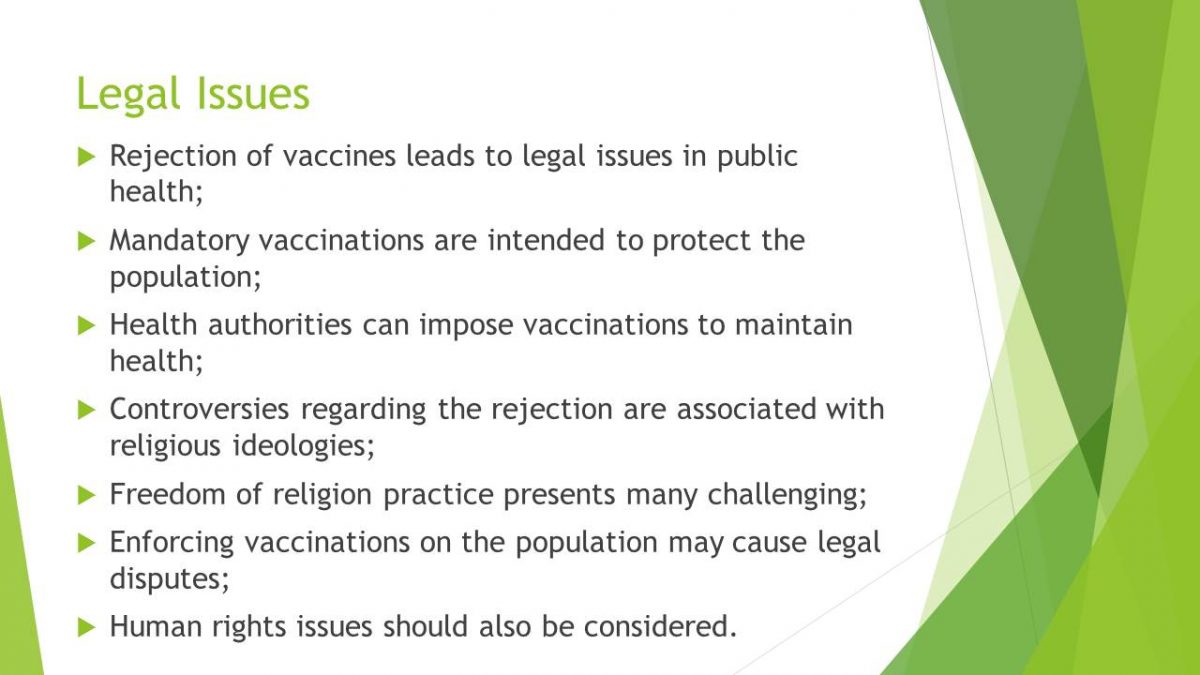
Cultural Considerations
- Certain cultures and belief systems oppose vaccinations;
- Some states allow a religious exemption to mandatory vaccinations;
- Protest against vaccines that contain human tissue cells;
- Infections can spread quickly through smaller groups (e.g., those attending the same church);
- “Western plot” theories in which populations in Asia and Africa believe;
- The polio vaccine has caused the most suspicion.
Some cultural groups may have a negative attitude toward immunizations due to the mistrust in their effectiveness as well as overall purpose.
Religious groups protest against the use of vaccines made with the help of human tissue cells. These groups consider the human body sacred and therefore unfit to be used for the purpose of immunization.
Some populations, especially in Africa and Asia, are opposed to vaccinations because of the fear of the Western world trying to control them.

Ethical Considerations
- Research and testing: may require the participation of human subjects;
- Importance of ensuring safety and efficacy of administered vaccines;
- Obtaining informed consent to administering vaccinations;
- Access to vaccinations is a socioeconomic issue;
- High-earning individuals will have greater access to vaccinations;
- Lacking infrastructure in poverty-stricken communities decreases the coverage of vaccinations.
Ethical considerations associated with vaccine administration fall into three categories: research and testing, informed consent, and access issues.
There is a problem of involving human subjects into research and testing because it can be potentially dangerous. Although, it is essential to ensuring that vaccines are safe and effective.
Informed consent is a problem if people disagree to get vaccinated. However, the most important ethical issue is concerned with access: immunizations are more likely to occur in economically stable populations.
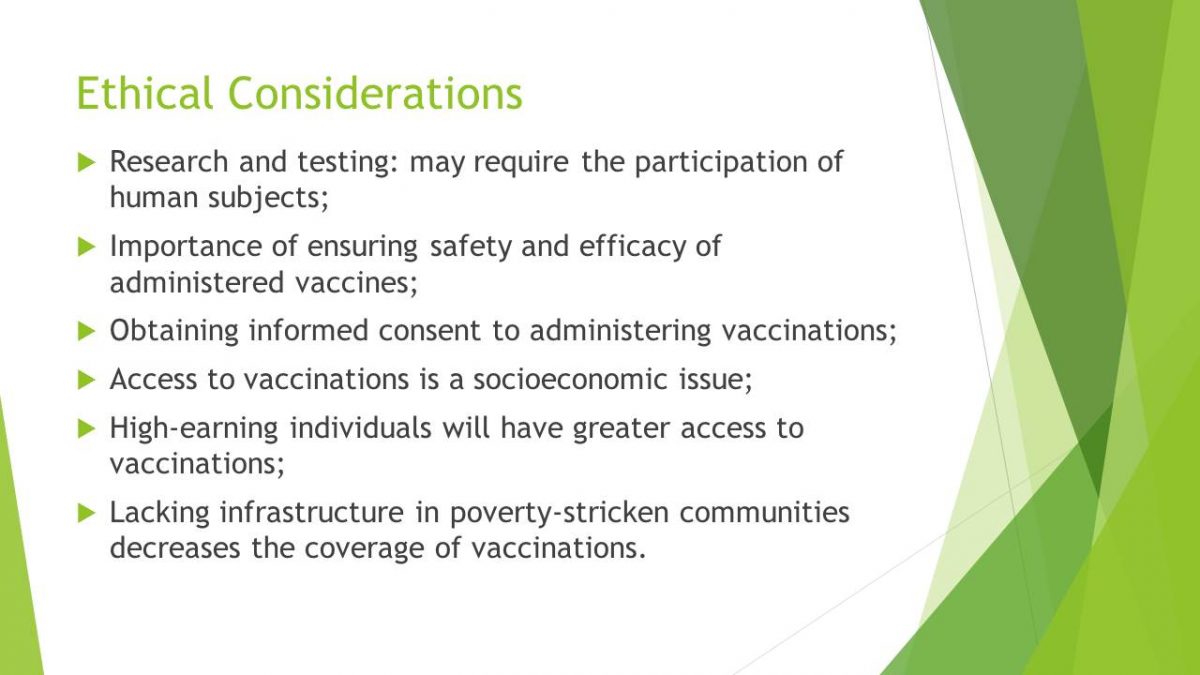
References
AAAAI. (2018). Vaccines: The myths and the facts. Web.
CDC. (2017). Infographic: The global impact of vaccines in reducing vaccine-preventable disease morbidity and mortality. Web.
Greenwood, B. (2014). The contribution of vaccination to global health: Past, present and future. Philosophical Transactions of the Royal Society of London. Series B, Biological sciences, 369(1645), 20130433.